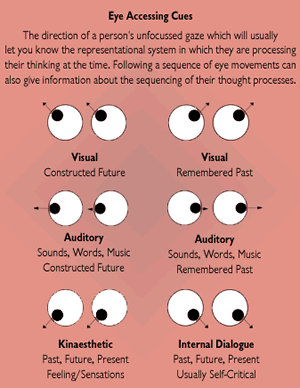Positive Health Online
Your Country

Neurolinguistic Psychotherapy for the Treatment of Depression Part II
listed in nlp, originally published in issue 178 - January 2011
Note: Part I can be found at www.positivehealth.com/article-view.php?articleid=2860
Submodalities - the Detailed Properties of our Mental Representations
Consider an image you are holding in your mind right now. Is it close or far away? Big or small? Two-dimensional, like a photograph, or three-dimensional ? Is it in colour, or black and white? Does it have an edge, or is it panoramic? These attributes have very strong connections to the way we feel about the scene we are mentally viewing. This is true, whether we are remembering something from the past, or imagining something in the future. Concerning a visual memory; we may speak of "reliving it, as though I was back there again", or of its having "faded", or of having "gained a perspective on it", or its having been embarrassing at the time but now seeming funny.
| REPRESENTATIONAL SYSTEMS | ||
| PERCEIVING EXTERNAL |
REPRESENTING INTERNALLY CONSTRUCTING REMEMBERING |
|
| VISUAL REPRESENTATIONAL SYSTEM | ||
| Seeing | Visualising Future | Visualising Past |
|
AUDITORY REPRESENTATIONAL SYSTEM
|
||
| HEARING Words, Sounds, Music |
IMAGINING SOUND Words, Sounds, Music Internal Dialogue |
REMEMBERING PAST Words, Sounds, Music Internal Dialogue |
| KINAESTHETIC REPRESENTATIONAL SYSTEM | ||
| FEELING Emotions, Sensations, (External, Internal) Motor Skills |
IMAGINING FEELINGS Emotions, Sensations, (External, Internal) Motor Skills |
REMEMBERING FEELINGS Emotions, Sensations, (External, Internal) Motor Skills |
| OLFACTORY REPRESENTATIONAL SYSTEM | ||
| SMELLING | IMAGINING SMELLS | REMEMBERING SMELLS |
| GUSTATORY REPRESENTATIONAL SYSTEM | ||
| TASTING | IMAGINING TASTES | REMEMBERING TASTES |
| There are thus roughly fifteen possible areas of attention, and virtually all behaviour consists of sequences of these. For purposes of writing out these sequences, we use the following notation: | |||
| Visual: V External: Ve Construct: Vc Recall: Vr |
Auditory: A External: Ae Construct: Ac Recall: Ar |
Kinaesthetic: K External: Ke Construct: Kc Recall: Kr |
Olfactory, Gustatory As the others |
Let us now direct our attention to auditory submodalities - volume, timbre, rhythm, pitch. And return to our depressed client (or self!). We are often prescribed 'positive affirmations' as an antidote to self-criticism. The problem is that we don't believe them. And we do believe the self-critical voice; after all, that's been going on all our lives, probably started by parents, siblings, teachers or school-mates - powerful figures in their day. Ask your client to pay deliberate attention to this special internal voice. Is it telling them that they are attractive, intelligent, lovable? No?
This question typically gets a wry smile. Ask your client to tell you some of the words they are hearing. Are they true? Do they contain useful or helpful information? If they do, that information is worth retaining. If not, or if the information is delivered in a hostile, contemptuous, or sarcastic tone, then you can begin to work with submodalities. Where does the voice seem to come from? Is it loud, quiet, low or high-pitched, slow and deliberate, or rapid-fire? You can ask your client to experiment with moving it around, changing the volume, pitch or pace. As this is done, it will be dawning on your client that this is something he can control, play around with. He or she can begin to make changes which will have a different emotional impact, and he /she can find changes which may make it sound ridiculously pompous, or just ridiculous.
In my work, I often compress submodality work by suggesting that the client get the voice going (reinforcing the new idea that it is in their control!), then gradually speed it up. As it gets quicker, it also gets more high-pitched, sounding like Mickey Mouse, then just a series of squeaks, then goes out of the audible range, like one of those high-frequency dog whistles. If the client finds she can do this, it usually makes them laugh - which is such a victory! The internal dialogue that used to make them miserable now just seems laughable. I then suggest that they teach themselves to notice that negative voice when it first begins, and turn up the speed immediately. If they do this enough times, their mind will begin to do it automatically. With the negative feelings deleted, our client begins to experience some emotional space, some freedom to notice things that make them feel good.
Richard Bandler makes another suggestion. Think about the way that someone who loves you says your name - that gentle, loving tone. Or think about your own response to a baby, or a kitten or puppy. Whatever brings on that 'awwwwww - isn't it sweet' feeling and tone of voice. Now, let the negative internal dialogue begin, but immediately change the tone of the voice into that 'awwww...'
Surprising things happen here. The client may suddenly get a sense that the critical person who first said those words was someone who loved them, wanted the best for them, but didn't realize that criticism wasn't the best way to go about it. Or they may realize that the words make absolutely no sense. Or the words may change into more positive, loving ones.

Sequences
The sequence which produced 'depression' probably started with a memory which made our client feel guilty or like a failure, (Vr) leading to feeling bad (K), followed by negative internal dialogue (ID) followed by feeling bad (K). We intervened first at the first part of the sequence, to change the emotional effect of the memory (re-viewing instead of re-living), changing 'feeling bad' to 'feeling compassionate towards the person they were in the memory - still K, but not 'feeling bad'. Then we intervened at the point in the sequence when ID leads to K (feeling bad). Now the ID submodalities have been altered so that the person feels either laughter, or loved, or just all right, instead of feeling bad.We can suggest that as well as practising these new ways of processing their thoughts, they take advantage of the fact that an upward gaze (look at the tops of the trees, the interesting roof-lines, the clouds) blocks the mental processes which can produce depression.
I hope this provides a clear description of the basic NLP concepts: representational systems, the eye movements related to representational systems, submodalities, and sequences as well as demonstrating their practical application in helping a person with depression.
As a therapist, healer, or self-healer, you will find these relatively simple and easy steps are more effective in dealing with depression that might seem at all possible. Richard Bandler would say, "Don't ask me to prove I'm right. Follow the directions, see if it works." You decide.
Abbreviations
Visual external - VeVisual remembered - Vr
Visual constructed - Vc
Auditory perception - sounds, words, or music - Ae
Auditory remembering - Ar
Auditory imagining - Ac sounds, words or music.
Kinaesthetic' external experience - Ke
Kinaesthetic internal remembering - Kr
Kinaesthetic imagining - Kc
Internal dialogue - ID
Comments:
-
No Article Comments available
